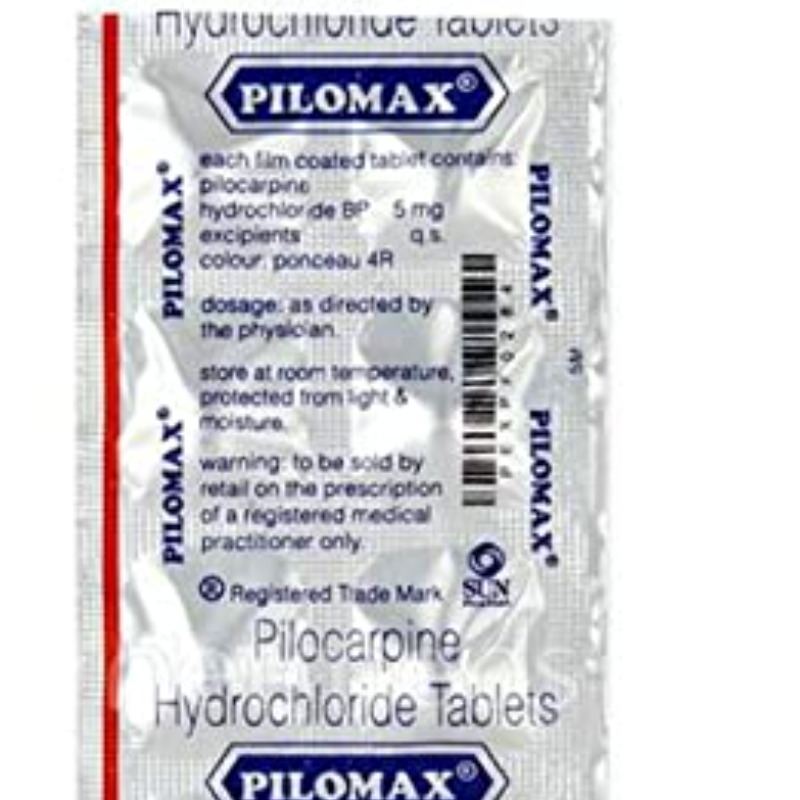DESCRIPTION
MECHANISM OF ACTION
Pilocarpine directly stimulates cholinergic receptors, acting on a subtype of muscarinic receptor (M3) found on
the iris sphincter muscle, causing
the muscle to contract and produce miosis. This effect is important in the short-term management of some angle-closure glaucomas..
ABSORPTION
From the 2% aqueous solution, pilocarpine was absorbed efficiently into the plasma (tmax = 3.6 ± 0.9 min, cmax = 0.384 ± 0.024 μg/ml).
Pharmacokinetic analysis of data for drug absorption revealed that the conjunctiva of the eye was the most important
site for systemic absorption of pilocarpine.
INDICATIONS
Pilocarpine hydrochloride tablets are indicated for 1) the treatment of symptoms of dry mouth from salivary gland hypofunction caused by radiotherapy for cancer of the head and neck; and 2) the treatment of symptoms of dry mouth in patients with Sjogren's Syndrome.
DOSAGE RANGE
Regardless of the indication, the starting dose in patients with moderate hepatic impairment should be 5 mg twice daily, followed by
adjustment based on therapeutic response and tolerability. Patients with mild hepatic insufficiency do not require dosage reductions.
The use of Pilocarpine in patients with severe hepatic insufficiency is not recommended. If needed, refer to the Hepatic
Insufficiency subsection of the Precautions section of this label for definitions of mild, moderate and severe hepatic impairment. Head
and Neck Cancer Patients: The recommended initial dose of Pilocarpine hydrochloride tablets is 5 mg taken three times a day. Dosage
should be titrated according to therapeutic response and tolerance. The usual dosage range is up to 15 to 30 mg per day.
(Not to exceed 10 mg per dose). Although early improvement may be realized, at least 12 weeks of uninterrupted therapy with Pilocarpine hydrochloride
tablets may be necessary to assess whether a beneficial response will be achieved. The incidence of the most common adverse events increases with dose.
The lowest dose that is tolerated and effective should be used for maintenance.
DRUG INTERACTION
Pilocarpine should be administered with caution to patients taking beta-adrenergic antagonists because of the possibility of conduction
disturbances. Drugs with parasympathomimetic effects administered concurrently with Pilocarpine would be expected to result
in additive pharmacologic effects. Pilocarpine might antagonize the anticholinergic effects of drugs used concomitantly.
These effects should be considered when anticholinergic properties may be contributing to the therapeutic effect of concomitant medication
(e.g., atropine, inhaled ipratropium). While no formal drug interaction studies have been performed, the following
concomitant drugs were used in at least 10% of patients in either or both Sjogren's efficacy studies: acetylsalicylic
acid, artificial tears, calcium, conjugated estrogens, hydroxychloroquine sulfate, ibuprofen, levothyroxine sodium, medroxyprogesterone
acetate, methotrexate, multivitamins, naproxen, omeprazole, paracetamol, and prednisone.
SPECIAL CONSIDERATIONS
1. Pilocarpine toxicity is characterized by an exaggeration of its parasympathomimetic effects. These may include: headache, visual disturbance,
lacrimation, sweating, respiratory distress, gastrointestinal spasm, nausea, vomiting, diarrhea, atrioventricular block,
tachycardia, bradycardia, hypotension, hypertension, shock, mental confusion, cardiac arrhythmia, and tremors.
2. The dose-related cardiovascular pharmacologic effects of Pilocarpine include hypotension, hypertension, bradycardia, and tachycardia.
3. Pilocarpine should be administered with caution to patients with known or suspected cholelithiasis or biliary tract disease. Contractions of the
gallbladder or biliary smooth muscle could precipitate complications including cholecystitis, cholangitis, and biliary obstruction.
4. Pilocarpine may increase ureteral smooth muscle tone and could theoretically precipitate renal colic (or "ureteral reflux"),
particularly in patients with nephrolithiasis.
5. Cholinergic agonists may have dose-related central nervous system effects. This should be considered when treating patients with underlying
cognitive or psychiatric disturbances.
6. Hepatic Insufficiency: Based on decreased plasma clearance observed in patients with moderate hepatic impairment, the starting dose in these patients
should be 5 mg twice daily, followed by adjustment based on therapeutic response and tolerability. Patients with mild hepatic
insufficiency (Child-Pugh score of 5 to 6) do not require dosage reductions. To date, pharmacokinetic studies in subjects with severe hepatic
impairment (Child-Pugh score of 10 to 15) have not been carried out. The use of Pilocarpine in these patients is not recommended.
TOXICITY
Pilocarpine toxicity rarely has been reported in the medical literature. Previous reports of toxicity have resulted from topical overuse,
intentional ingestion or unintentional injection of ophthalmic drops. The oral administration of pilocarpine tablets
recently has become a common treatment for xerostomia.
SPECIFICATION


Login To Comment